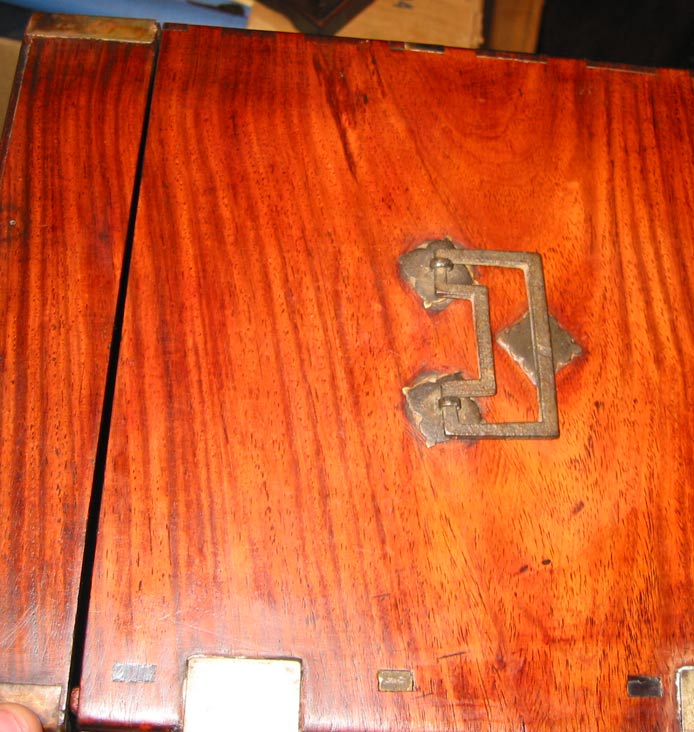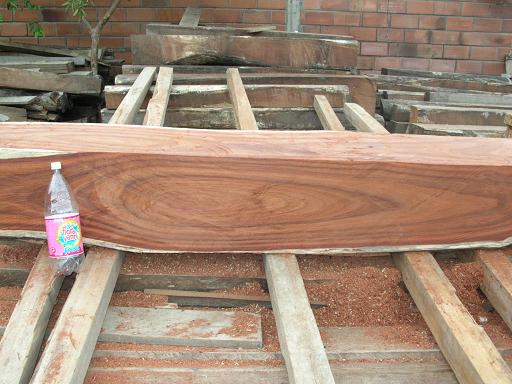
|
Subject:Re: Huanghuali or Hongmu
Posted By: Ph. Papadimitriou Thu, Sep 29, 2011
Hello.
This is a flower stand, not an incense stand.
This is Japanese, not Chinese.
This is a Meiji (probably late) piece for decoration, not an imperial piece of the highest standards.
This is, according to a Japanese designation, made of "karaki" ("chinese wood" = a wood of initial Chinese origin), not Huanghuali. Karaki comprises many types of wood, among which different types of rosewood (matching the Chinese Hongmu), but also ironwood (that some consider similar to Tielimu; not me) and other woods. I have yet to better understand what shitan means in Japanese terms, because many shitan pieces are indeed very dark (almost black) wooden objects that are often not tagged karaki. They are not matching Chinese Zitan in any way, but would more correspond to dark kinds of Hongmu in my humble opinion. Maybe Japanese do only confuse other woods with what they hope is Zitan and thus tag them shitan (?). Longan wood is much sought after in Japan too and is not tagged karaki there, even if most of the trees seem to have grown in the coastal regions of the Fujian province or Taiwan.
The dragon is Japanese in design, not Chinese, and it even is quite representative of Meiji pieces. I have seen some objects tagged "made in US occupied Japan" that were displaying what I consider very similar examples of dragons. I myself have a small metal box with this inscription and three dragons on it (the box is of no real value - I acquired it in a local fleemarket for 1 Swiss frank).
The design of the legs, the losange-oriented square plank at the bottom, its grooved sides and finish reproduced on top, the carved decorations, the proportions, the probable height (I would say near 50cm, rather than the usual 80-85cm for a Chinese incense stand) and probably the joinery are indications to what I here conclude.
A nice decorative piece nonetheless.
Phil
PS: We have to remember that Japanese craftsmen have created many objects that are directly or indirectly inspired by Chinese art. When it comes to stands (for incense, for bonzai, for displaying vases in the tokonoma during tea, etc.), examples are clearly showing many Chinese objects were brought to Japan and were highly regarded to in the end be copied (with Chinese monks, trade through the Philippines, etc.). Many Japanese "scroll stands" rival with their Chinese counterparts. Most of them are made of karaki (=Hongmu). I sometimes wonder how many of such stands were once considered Chinese wrongly.


|
 Huanghuali or Hongmu
Huanghuali or Hongmu  ( China & Japan ) - LEE - Jan 27, 2010 (01:57 AM)
( China & Japan ) - LEE - Jan 27, 2010 (01:57 AM)  Re: Huanghuali or Hongmu - kk - Jan 27, 2010 (09:24 PM)
Re: Huanghuali or Hongmu - kk - Jan 27, 2010 (09:24 PM)  Re: Huanghuali or Hongmu - LEE - Jan 27, 2010 (11:34 PM)
Re: Huanghuali or Hongmu - LEE - Jan 27, 2010 (11:34 PM)  Re: Huanghuali or Hongmu - kk - Jan 28, 2010 (11:10 PM)
Re: Huanghuali or Hongmu - kk - Jan 28, 2010 (11:10 PM)  Re: Huanghuali or Hongmu
Re: Huanghuali or Hongmu  - LEE - Jan 29, 2010 (06:27 PM)
- LEE - Jan 29, 2010 (06:27 PM)  Re: Huanghuali or Hongmu
Re: Huanghuali or Hongmu  - LEE - Jan 29, 2010 (07:51 PM)
- LEE - Jan 29, 2010 (07:51 PM)  Re: Huanghuali or Hongmu
Re: Huanghuali or Hongmu  - kk - Feb 02, 2010 (01:58 PM)
- kk - Feb 02, 2010 (01:58 PM)  Re: Huanghuali or Hongmu - LEE - Feb 03, 2010 (02:59 AM)
Re: Huanghuali or Hongmu - LEE - Feb 03, 2010 (02:59 AM)  Re: Huanghuali or Hongmu - Roger Schwendeman - Feb 06, 2010 (02:12 AM)
Re: Huanghuali or Hongmu - Roger Schwendeman - Feb 06, 2010 (02:12 AM)  Re: Huanghuali or Hongmu - kk - Feb 06, 2010 (08:45 PM)
Re: Huanghuali or Hongmu - kk - Feb 06, 2010 (08:45 PM)  Re: Huanghuali or Hongmu - Roger - Nov 14, 2010 (05:33 AM)
Re: Huanghuali or Hongmu - Roger - Nov 14, 2010 (05:33 AM)  Re: Huanghuali or Hongmu - Elaine - Oct 27, 2010 (12:30 AM)
Re: Huanghuali or Hongmu - Elaine - Oct 27, 2010 (12:30 AM)  Re: Huanghuali or Hongmu - john n. - Nov 17, 2010 (08:43 PM)
Re: Huanghuali or Hongmu - john n. - Nov 17, 2010 (08:43 PM)  Re: Huanghuali or Hongmu - john n. - Nov 17, 2010 (08:45 PM)
Re: Huanghuali or Hongmu - john n. - Nov 17, 2010 (08:45 PM)  Re: Huanghuali or Hongmu - LEE - Nov 24, 2010 (01:26 AM)
Re: Huanghuali or Hongmu - LEE - Nov 24, 2010 (01:26 AM)  Re: Huanghuali or Hongmu - Kirkwood Paterson - Sep 07, 2012 (12:53 PM)
Re: Huanghuali or Hongmu - Kirkwood Paterson - Sep 07, 2012 (12:53 PM)  Re: Huanghuali or Hongmu - Ph. Papadimitriou - Mar 18, 2011 (09:28 AM)
Re: Huanghuali or Hongmu - Ph. Papadimitriou - Mar 18, 2011 (09:28 AM)  Re: Huanghuali or Hongmu
Re: Huanghuali or Hongmu  - Torben Hedvall - Sep 29, 2011 (04:06 AM)
- Torben Hedvall - Sep 29, 2011 (04:06 AM)  Re: Huanghuali or Hongmu - Ph. Papadimitriou - Sep 29, 2011 (07:15 AM)
Re: Huanghuali or Hongmu - Ph. Papadimitriou - Sep 29, 2011 (07:15 AM)  Re: Huanghuali or Hongmu - Ph. Papadimitriou - Sep 29, 2011 (07:41 AM)
Re: Huanghuali or Hongmu - Ph. Papadimitriou - Sep 29, 2011 (07:41 AM)  Re: Huanghuali or Hongmu
Re: Huanghuali or Hongmu  - Kirkwood Paterson - Sep 07, 2012 (01:42 PM)
- Kirkwood Paterson - Sep 07, 2012 (01:42 PM)  Re: Huanghuali or Hongmu - sj - May 21, 2014 (03:26 AM)
Re: Huanghuali or Hongmu - sj - May 21, 2014 (03:26 AM)  Re: Huanghuali or Hongmu - Torben Hedvall - Mar 05, 2015 (11:10 AM)
Re: Huanghuali or Hongmu - Torben Hedvall - Mar 05, 2015 (11:10 AM) 
